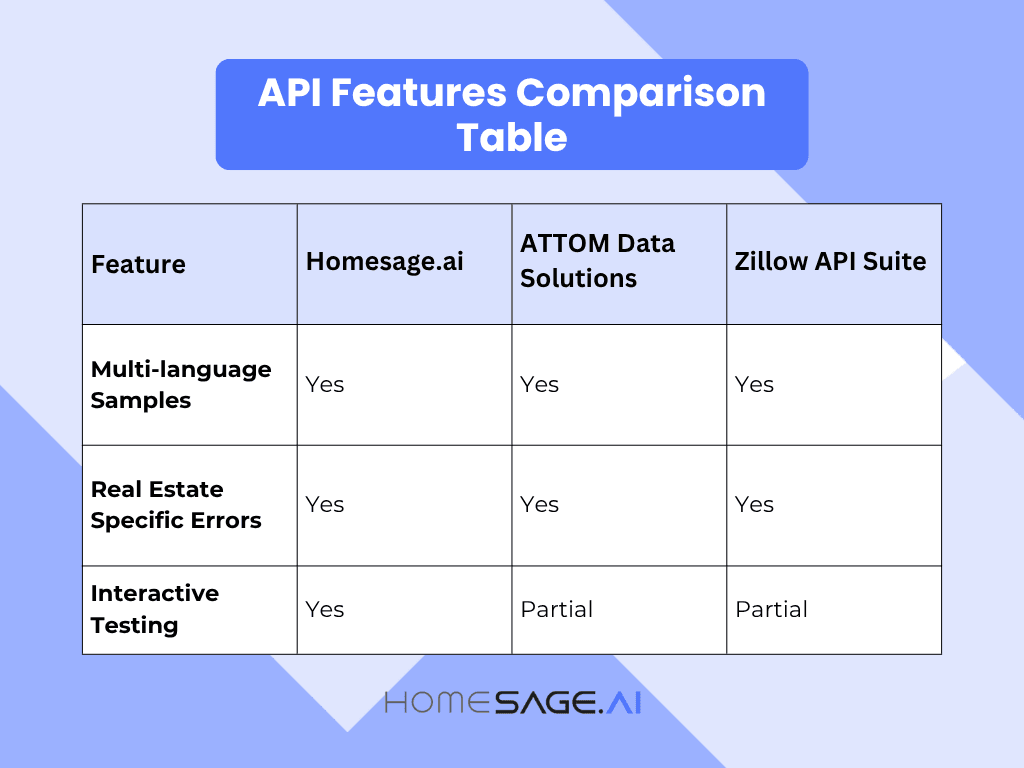Every IT developer working with real estate APIs knows the pain of poor documentation—vague endpoint instructions, missing authentication details, and unhelpful code samples. All of these issues slow down integration and frustrate development teams.
In 2026, PropTech success will be tightly linked to how well providers support developers with tools and guides engineered for speed, clarity, and reliability.

1. Why Documentation Defines Developer Experience
A developer’s journey with any API starts with reading the documentation. Over 80% of developers say clear docs are their top priority when selecting a new API. In real estate, mistakes from poor documentation can cause costly delays and break business workflows.
Effective documentation is more than a “how-to”—it’s the first promise of support, trust, and partnership between provider and builder.
Well-documented APIs shorten the “time-to-first-call,” which is how fast a developer can make a successful request. When the guide is clear, developers spend less time troubleshooting and more time building.
2. Interactivity and Immediate Testing
Old, static docs aren’t enough anymore. Modern PropTech APIs let developers test endpoints instantly in their browser, removing the need for complex setups. These tools show real, live responses from the API, helping users learn how data flows before ever opening their code editor.
Interactive documentation means developers can plug in their credentials and see how changing parameters affects the outcome. With this, teams can verify if the API fits their needs in minutes, not days.
Homesage.ai offers transparent onboarding with over 20 AI-based endpoints that developers can test in real time, including Property Condition API, Investment Potential API, and Renovation Cost API.

3. Authentication Flows That Prevent Delays
Authentication is one of the biggest stumbling blocks for API adoption. Developers need step-by-step guides covering token generation, security practices, and how to refresh access, with diagrams and actual error messages.
APIs that use standards like OAuth2, JWT, or simple API keys are preferred, but they must also explain the differences and their security implications.
While the infographic above highlights the visual process, the table below compares API documentation platforms side-by-side to help teams evaluate key differences

4. Multi-Language Code Examples
Flexibility matters. Developers use Python, JavaScript, Java, Ruby, and more—so real estate APIs must show code snippets for popular stacks. The best docs include full working examples for common tasks such as searching for properties, calculating investments, or estimating renovation costs.
Homesage.ai offers robust documentation with sample code across its 20+ specialized endpoints.
These endpoints deliver AI-powered analytics, including After Repair Value, Renovation Cost Estimates, Flip ROI, rental projections, and Price Flexibility Score—features designed explicitly for investment workflows. By making code easy to copy and run, they help real estate platforms and contractors launch integrations efficiently.

5. Endpoint Clarity and Data Models
Each API endpoint must include a section explaining the POST/GET method, request parameters with sample values, expected responses, and clear data models.
This includes specifying the types for address, price, status fields, and the timing of data updates. Visualizing nested objects like comps or valuation trends helps developers see how everything connects.
Homesage.ai provides comprehensive endpoint documentation across its API suite, including Property Information API, Renovation Cost API, Renovation Return ROI API, Flip Return API, TLC API, Home Value Graph API, Long-Term Rental API, Short-Term Rental API, Comps API, Price Flexibility Score API, and Full Report API.
Each endpoint details required and optional inputs, acceptable value ranges, and typical output formats.
6. Sandbox Environments for Risk-Free Testing
Developers shouldn’t use production keys for testing. Sandbox environments mirror the live system but use fake data and are free, letting developers safely experiment with endpoints, authentication, and error handling. Transitioning between sandbox and production should be easy, with all steps documented.
Homesage.ai offers testing environments where users can experiment with flipping returns, rental projections, renovation ROI, and investment scoring APIs before going live.
The platform supports easy integration with staging controls and sample-based guidance, reducing risks and speeding deployment for developers building solutions for investors, agents, and contractors.
7. Error Handling That Solves Problems
No API integration goes perfectly the first time. Straightforward error docs help developers recognize problems fast, whether it’s a bad API key, invalid data, or a rate limit breach.
The best docs categorize errors, describe common causes, and include examples of requests that trigger each one, helping teams avoid unnecessary support calls.
Homesage.ai‘s documentation includes real estate-specific error handling for scenarios such as property data being unavailable, invalid listing formats, or address validation failures.
The platform provides active technical support and robust FAQ sections, helping developers quickly adjust their approach and resolve coding hurdles.
8. Versioning and Deprecation Policies
APIs change, so clear versioning and sunset policies are essential. The docs should highlight current versions, describe what’s changed, and provide migration guides. Changelogs with new features and fixes help development teams plan upgrades without breaking current projects.
9. Rate Limiting and Performance Transparency
Real estate platforms may process thousands of property queries. Developers need to know upfront how many requests they can send, what happens when they exceed limits, and best practices for batching or caching data.
This helps teams design user apps to avoid performance bottlenecks.
Rate Limits & Performance | Homesage.ai | ATTOM Data Solutions | Zillow API Suite |
Rate Limit Transparency | Yes | Yes | Partial |
Performance Metrics | Yes | Partial | Partial |
10. Searchable and Organized Navigation
An overloaded documentation page isn’t much help. The best APIs use sidebars, top navs, and robust search so developers can instantly jump to guides, endpoint descriptions, code snippets, or troubleshooting tips. Crisp layout and syntax highlighting make it easy to read, even on mobile.
Homesage.ai organizes documentation by use case—investment analysis, rental projections, renovation intelligence, property condition assessment—so contractors, agents, lenders, and PropTech developers can zero in on what matters for their project.
The platform’s sample-based documentation with clear examples accelerates integration timelines.
11. Practical Use Cases and Integration Guides
Generic docs leave developers guessing. Instead, practical guides walk through building a property search, creating rental calculators, or estimating profit from a house flip.
Purpose-built walkthroughs with screenshots and annotated code help users tie API responses to actual business workflows.
Homesage.ai showcases full use-case implementations across multiple real estate professional needs. For example, combining Property Information API, Renovation Cost API, and Investment Potential API helps agents and investors identify renovation opportunities. The TLC API flags properties with renovation potential for contractors, while the Flip Return API calculates potential returns, including costs, profits, and ROI.
12. Support Resources and Developer Community
No documentation is perfect. The best APIs back up their docs with human support—ticket systems, live chat, or dedicated channels that offer quick answers for builders stuck during integration.
Regular updates, active forums, and clear escalation paths build trust and foster community culture.

Key Takeaways
- Clear documentation speeds up integrations, lowers support costs, and improves developer confidence for PropTech applications.
- Homesage.ai‘s 20+ AI-powered endpoints, interactive testing capabilities, multi-language samples, and real estate-specific troubleshooting set it apart from competitors like ATTOM Data Solutions and Zillow.
- Sandbox environments, transparent versioning, performance-optimization guidance, and robust technical support enable fast, risk-free launches of property technology solutions for 140+ million US properties.
- The comprehensive API suite, covering property intelligence, investment analysis, renovation estimates, and market insights, includes documentation designed to accelerate developer success.
Watch this quick video from Homesage.ai to see how modern real estate APIs streamline data access for IT developers.
Conclusion
Great real estate API documentation is more than technical notes—it’s a strategic asset for PropTech platforms that want reliable integrations and happy developer partners. Homesage.ai demonstrates how smart documentation helps agents, contractors, lenders, and developers move quickly from concept to reality with actionable property data powered by AI-driven investment analytics and comprehensive property insights.
The difference between frustrated debugging sessions and smooth integrations often comes down to the documentation quality that developers actually want to use. Start building smarter real estate solutions by choosing APIs with documentation that truly supports your team’s success.
Frequently Asked Questions
Q: What makes real estate API documentation developer-friendly?
A: Developer-friendly real estate API documentation combines interactive testing environments, comprehensive code examples in multiple languages, clear authentication flows, and practical use cases.
Homesage.ai provides these features through over 20 specialized endpoints, instant API key generation, robust documentation, and sample-based guidance, accelerating integration across investment analysis, renovation intelligence, and property condition assessment workflows.
Q: Why do developers prefer Homesage.ai over competitors like ATTOM or Zillow APIs?
A: Homesage.ai‘s API suite delivers specialized, AI-powered property intelligence with documentation engineered for quick onboarding and actionable investment insights.
The platform covers over 140 million US properties with unique endpoints, including Investment Potential API, Price Flexibility Score, Renovation ROI, and TLC API capabilities not available in traditional real estate APIs.
Q: What authentication methods does Homesage.ai use?
A: Homesage.ai uses API key authentication with instant generation and transparent onboarding. The platform provides step-by-step documentation for token setup, secure data transmission via HTTPS encryption, and compliance with data privacy standards, ensuring safe and smooth deployments.
Q: How does sandbox testing benefit developers using Homesage.ai?
A: Sandbox environments let developers test Homesage.ai‘s endpoints for flipping returns, rental projections, renovation cost estimates, and investment scoring without affecting live data or incurring costs.
The platform supports staging environments with sample data, helping IT teams experiment with AI-powered analytics before production deployment.




1 Comment
Hamza 11 hours ago
Good insight!